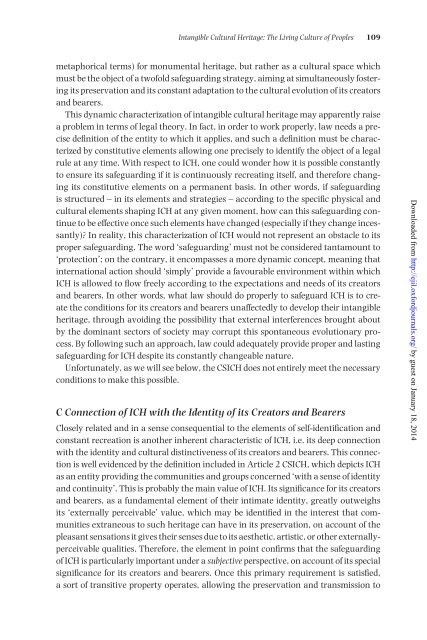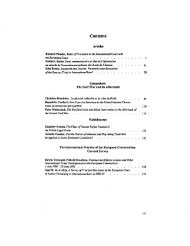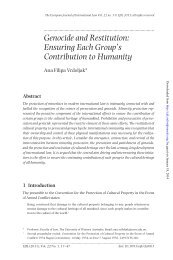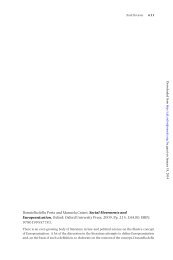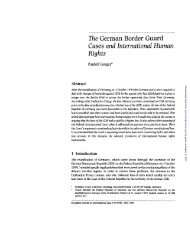Intangible Cultural Heritage - European Journal of International Law
Intangible Cultural Heritage - European Journal of International Law
Intangible Cultural Heritage - European Journal of International Law
Create successful ePaper yourself
Turn your PDF publications into a flip-book with our unique Google optimized e-Paper software.
<strong>Intangible</strong> <strong>Cultural</strong> <strong>Heritage</strong>: The Living Culture <strong>of</strong> Peoples 109<br />
metaphorical terms) for monumental heritage, but rather as a cultural space which<br />
must be the object <strong>of</strong> a tw<strong>of</strong>old safeguarding strategy, aiming at simultaneously fostering<br />
its preservation and its constant adaptation to the cultural evolution <strong>of</strong> its creators<br />
and bearers.<br />
This dynamic characterization <strong>of</strong> intangible cultural heritage may apparently raise<br />
a problem in terms <strong>of</strong> legal theory. In fact, in order to work properly, law needs a precise<br />
definition <strong>of</strong> the entity to which it applies, and such a definition must be characterized<br />
by constitutive elements allowing one precisely to identify the object <strong>of</strong> a legal<br />
rule at any time. With respect to ICH, one could wonder how it is possible constantly<br />
to ensure its safeguarding if it is continuously recreating itself, and therefore changing<br />
its constitutive elements on a permanent basis. In other words, if safeguarding<br />
is structured – in its elements and strategies – according to the specific physical and<br />
cultural elements shaping ICH at any given moment, how can this safeguarding continue<br />
to be effective once such elements have changed (especially if they change incessantly)?<br />
In reality, this characterization <strong>of</strong> ICH would not represent an obstacle to its<br />
proper safeguarding. The word ‘safeguarding’ must not be considered tantamount to<br />
‘protection’; on the contrary, it encompasses a more dynamic concept, meaning that<br />
international action should ‘simply’ provide a favourable environment within which<br />
ICH is allowed to flow freely according to the expectations and needs <strong>of</strong> its creators<br />
and bearers. In other words, what law should do properly to safeguard ICH is to create<br />
the conditions for its creators and bearers unaffectedly to develop their intangible<br />
heritage, through avoiding the possibility that external interferences brought about<br />
by the dominant sectors <strong>of</strong> society may corrupt this spontaneous evolutionary process.<br />
By following such an approach, law could adequately provide proper and lasting<br />
safeguarding for ICH despite its constantly changeable nature.<br />
Unfortunately, as we will see below, the CSICH does not entirely meet the necessary<br />
conditions to make this possible.<br />
C Connection <strong>of</strong> ICH with the Identity <strong>of</strong> its Creators and Bearers<br />
Closely related and in a sense consequential to the elements <strong>of</strong> self-identification and<br />
constant recreation is another inherent characteristic <strong>of</strong> ICH, i.e. its deep connection<br />
with the identity and cultural distinctiveness <strong>of</strong> its creators and bearers. This connection<br />
is well evidenced by the definition included in Article 2 CSICH, which depicts ICH<br />
as an entity providing the communities and groups concerned ‘with a sense <strong>of</strong> identity<br />
and continuity’. This is probably the main value <strong>of</strong> ICH. Its significance for its creators<br />
and bearers, as a fundamental element <strong>of</strong> their intimate identity, greatly outweighs<br />
its ‘externally perceivable’ value, which may be identified in the interest that communities<br />
extraneous to such heritage can have in its preservation, on account <strong>of</strong> the<br />
pleasant sensations it gives their senses due to its aesthetic, artistic, or other externallyperceivable<br />
qualities. Therefore, the element in point confirms that the safeguarding<br />
<strong>of</strong> ICH is particularly important under a subjective perspective, on account <strong>of</strong> its special<br />
significance for its creators and bearers. Once this primary requirement is satisfied,<br />
a sort <strong>of</strong> transitive property operates, allowing the preservation and transmission to<br />
Downloaded from http://ejil.oxfordjournals.org/ by guest on January 18, 2014


